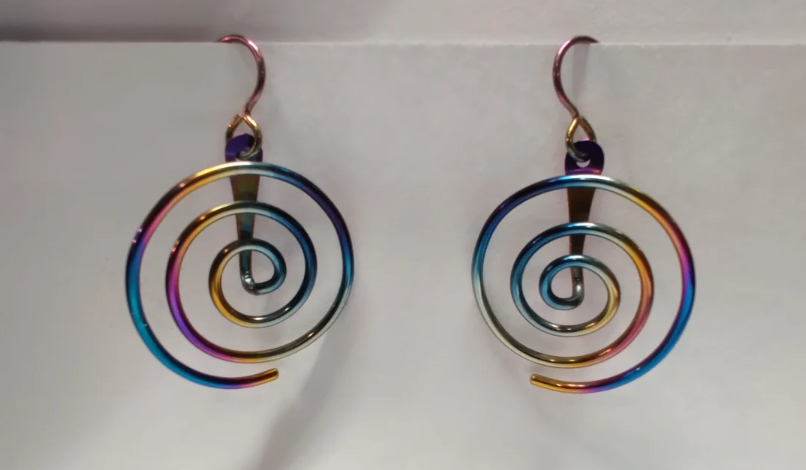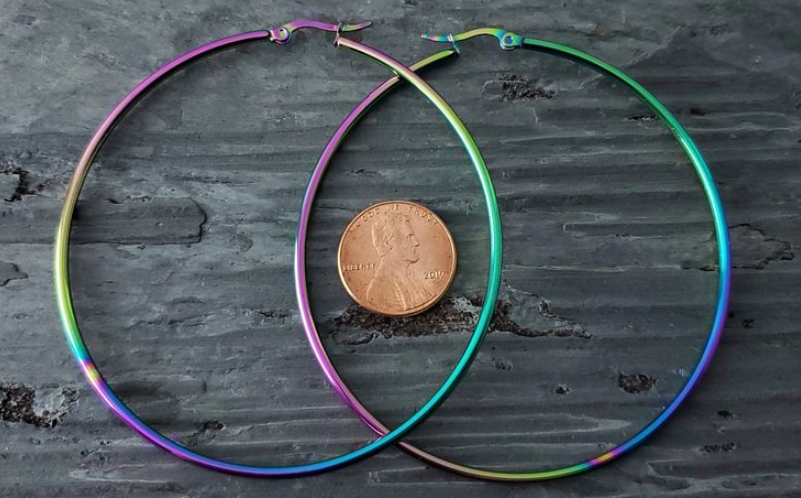In jewelry-making, gold, silver, and platinum have reigned supreme for centuries, becoming synonymous with beauty, durability, and value.
However, as innovation shapes the world of jewelry design, alternative materials come to the forefront, challenging traditional perspectives and offering unique benefits to both the wearer and the artisan.
Enter niobium, a lustrous, hypoallergenic metal increasingly finding its way into the studios of contemporary jewelers and onto the wish lists of discerning buyers. But is niobium indeed cut out for the coveted world of fine jewelry?
In this article, we’ll delve deep into the properties of niobium, exploring its advantages, limitations, and potential role in revolutionizing the way we think about adornment.
Whether you’re a seasoned jewelry aficionado or simply curious about this emerging material, prepare to embark on a journey that shines a light on the captivating world of niobium jewelry.
The History Of Niobium Jewelry: From Ancient Times To Modern Times
Ancient Discoveries: Unearthing Niobium’s Roots
While niobium might seem like a modern revelation in the jewelry world, its discovery dates back to ancient times.
Historians have found artifacts and references hinting at the use of a metal similar to niobium by ancient civilizations. However, they needed the means to isolate or identify it as we do today.
Often, this metal was mistakenly identified or alloyed with other metals due to its close properties to tantalum.
The 18th Century: Official Discovery and Initial Exploration
The actual credit for discovering niobium goes to an English chemist named Charles Hatchett in 1801.
He named the new element “columbium” after the American continent’s poetic name, Columbia. Columbium and tantalum were often confused or thought to be the same element for several decades due to their similar properties.
It was in the later 1800s that scientists conclusively distinguished between the two.
The 20th Century: Emergence in Commercial Applications
The 20th century saw significant advancements in metallurgy, enabling more extensive utilization of niobium.
While its primary uses were in the aerospace and electronics industry because of its heat-resistant properties, jewelers began to recognize its potential.
The hypoallergenic quality of niobium and its ability to be anodized into a spectrum of vibrant colors made it an attractive option for experimental jewelry designers.
Modern Times: Niobium’s Rise in the World of Jewelry
In recent decades, niobium has gained popularity among both jewelry designers and consumers.
The modern appreciation for unique, non-traditional pieces has catapulted niobium to the spotlight. Its hypoallergenic nature makes it particularly appealing to those with metal sensitivities.
Moreover, artisans cherish niobium for its malleability and the rainbow of colors they can achieve through the anodization process.
Today, from earrings to necklaces, niobium pieces stand out as both art and adornment, marrying ancient allure with contemporary charm.
The Future: Where Niobium is Headed
While the history of niobium in jewelry is shorter than gold or silver, its trajectory is promising. With increasing awareness about metal allergies and the continuous demand for distinctive pieces, Niobium’s future in the jewelry world is bright.
As techniques evolve and designers push boundaries, we can expect even more innovative and breathtaking niobium creations in the years to come.
Understanding Niobium: Basic Properties
Niobium, denoted by the chemical symbol Nb, is an elemental metal classified under the refractory metals group. This means it can withstand exceptionally high temperatures without melting or losing its form.
Key Physical and Chemical Characteristics
1. Lustrous and Ductile: Niobium is characterized by its shiny gray-white appearance. Its ductility, which is the ability to be drawn into thin wires, makes it a favorable choice for intricate jewelry designs.
2. Corrosion Resistant: One of the standout features of niobium is its excellent corrosion resistance. This means it doesn’t tarnish or corrode when exposed to the elements or come in contact with the skin. This property alone can make it an attractive choice for jewelry.
3. Hypoallergenic: Niobium is naturally hypoallergenic. This is crucial for jewelry as many people have allergies to common metals like nickel. Niobium jewelry reduces the risk of allergic reactions, making it suitable for those with sensitive skin.
4. High Melting Point: With a melting point of approximately 2,468°C (4,474°F), niobium can endure high temperatures. While this might not seem directly relevant for jewelry, it speaks to the metal’s overall durability and stability.
5. Malleability and Workability: Due to its ductility and malleability (the ability to be hammered or rolled into thin sheets), niobium can be shaped into many unique and intricate designs, a trait that jewelry artisans can certainly appreciate.
6. Color Versatility: One of the most enchanting characteristics of niobium in jewelry is its ability to produce a wide spectrum of vibrant colors when subjected to electrolytic anodizing. This process alters the refractive properties of the oxide layer on its surface, resulting in jewelry pieces ranging from deep blues and purples to radiant golds and greens without dyes or pigments.
The inherent properties of niobium, from its hypoallergenic nature to its captivating color palette, make it an intriguing option and a potential game-changer in the jewelry world.
The Benefits of Using Niobium in Jewelry Compared To Other Metals
1. Hypoallergenic Nature
Niobium’s suitability for sensitive skin: Niobium is an exceptionally hypoallergenic metal, making it an excellent choice for sensitive skin or metal allergies. Unlike other metals that can cause irritation or allergic reactions, niobium rarely causes such issues.
Comparison to common allergenic metals: Many popular metals used in jewelry, such as nickel and even some alloys of gold and silver, can cause reactions in sensitive individuals. Niobium, on the other hand, is consistently well-tolerated, making it a safer alternative for those prone to skin reactions.
2. Durability and Corrosion Resistance
Resistance to tarnishing and oxidation: One of niobium’s standout properties is its impressive resistance to tarnishing and oxidation. This means that niobium jewelry retains its luster and beauty over time, requiring minimal maintenance.
Longevity when worn regularly: Thanks to its robust nature, niobium can withstand the wear and tear of daily use, ensuring that pieces made from this metal are beautiful and long-lasting.
Versatility in Color and Design
Anodizing Niobium: One of the most intriguing aspects of niobium is its ability to be anodized. This process allows for the creation of a spectrum of vibrant colors, from deep blues to radiant purples, without using dyes or pigments.
Unique and customizable designs: With its colorful potential, niobium offers designers a unique canvas to create distinctive, bespoke jewelry pieces that cater to individual tastes.
3. Flexibility and Malleability
Crafting intricate designs: Niobium’s flexibility means that it can be molded into intricate designs and patterns. Despite this malleability, it doesn’t lose its structural integrity, ensuring that the final product is both delicate in appearance and robust in structure.
4. Environmental Impact
Sustainable sourcing: Unlike some metals that have significant environmental footprints due to mining, niobium can be sourced in ways that are less damaging to the environment, making it a more sustainable choice for eco-conscious consumers and designers.
5. Heat Resistance
Stability at high temperatures: Niobium doesn’t easily react to high temperatures, which can be particularly useful during crafting. This heat resistance ensures that the metal doesn’t degrade or discolor when exposed to high heat, preserving its quality and appearance.
6. Weight and Comfort
Lightweight feel: Despite its strength, niobium is relatively lightweight, making jewelry crafted from it comfortable to wear. This can be especially advantageous for larger statement pieces, ensuring they feel manageable when worn.
With all these compelling advantages, it’s clear that niobium is not just a fleeting trend in the jewelry world but a metal with undeniable potential to redefine beauty standards, comfort, and durability.
Niobium Allergies: Are They a Concern For Jewellers?
To comprehend the relevance of niobium in the context of allergies, one must first understand the nature of metal allergies.
These allergic reactions primarily arise due to metals like nickel, cobalt, and sometimes even gold and silver, which can irritate the skin when worn for prolonged periods.
Itching, redness, swelling, and even blisters can manifest in people with sensitivities to these metals, making the selection of jewelry a critical process for many.
Niobium’s Hypoallergenic Nature
Niobium sets itself apart in this conversation due to its hypoallergenic properties. It is inherently nickel-free, making it an excellent choice for sensitive skin.
Its chemical inertness ensures that it doesn’t react with skin oils and acids, even further reducing the risk of allergies.
This unique trait has led many jewelers to opt for niobium, especially when crafting earrings or other pieces that come into close contact with the skin.
Compared with Other Hypoallergenic Metals
While niobium boasts of its hypoallergenic nature, it isn’t the only metal in this category. Metals like titanium and surgical steel are also often considered for sensitive skin.
However, niobium’s advantage lies in its malleability and vibrant anodized colors, which offer jewelers more artistic freedom without compromising on wearer comfort.
Safety in Niobium Processing
For jewelers, working with niobium poses minimal health risks. The metal doesn’t release harmful fumes or toxins when shaped, soldered, or polished.
That said, like with any metalwork, jewelers should employ standard safety precautions to prevent inhalation of dust or particles during the crafting process.
A Safe Bet for Both Crafters and Wearers
When it comes to concerns about allergies, niobium emerges as a clear winner in the realm of jewelry metals.
Its hypoallergenic nature ensures a comfortable experience for wearers, while its ease of manipulation and inherent safety make it an attractive choice for jewelers.
As more people become aware of metal sensitivities and seek alternative materials, niobium’s popularity in the jewelry world is poised to soar.

Considerations When Buying Niobium Jewelry
As niobium steadily makes its way into the jewelry scene, prospective buyers may find themselves with a series of considerations before purchasing.
This beautiful metal, with its captivating colors and hypoallergenic properties, offers a refreshing alternative, but understanding its price, comparison to other metals, and availability is crucial.
Let’s delve into these aspects.
Price Point
1. Comparison of Niobium’s Cost to Other Popular Jewelry Metals:
Generally, niobium is considered a more affordable option when compared to premium metals like gold, platinum, or palladium. However, the price can vary based on craftsmanship, design intricacy, and any combination with other metals or gemstones.
Silver, another popular jewelry choice, might be comparable in price to niobium, although this fluctuates with market conditions. Factors such as design exclusivity, brand prestige, and regional variations can also influence the cost.
It’s essential to remember that while the metal’s cost is a factor, the labor, artistic value, and brand can significantly influence the final price of a jewelry piece.
Availability and Variety
1. The Relative Rarity of Niobium Jewelry Compared to More Traditional Materials:
Niobium jewelry, while growing in popularity, is still less common than pieces made from traditional metals like gold or silver. This rarity can be an attraction for those seeking unique and less mainstream jewelry.
As a result of its relative novelty in the jewelry world, there’s a burgeoning innovation in designs crafted from niobium. From intricate patterns to avant-garde styles, niobium pieces often blend tradition with contemporary artistry.
Where to Find and Purchase Niobium Jewelry
1. Specialized Jewelry Stores: Some boutiques and specialty jewelry shops, especially those focusing on contemporary designs or hypoallergenic options, may carry niobium pieces.
2. Online Platforms: As the digital marketplace flourishes, numerous online jewelry retailers offer niobium pieces. Websites like Etsy might have independent artisans showcasing unique niobium designs.
3. Craft Fairs and Art Shows: Given the artistic appeal of niobium and its growing trend among modern artisans, craft fairs, and art exhibitions can be ideal places to discover handcrafted niobium jewelry.
4. Custom Orders: If you’re seeking something uniquely tailored to your taste, consider approaching a jeweler for a custom design. Given niobium’s malleability and color variation through anodization, it’s a favorite for bespoke creations.
How to care for Niobium Jewelry
Niobium, known for its deep, radiant colors and natural hypoallergenic characteristics, has found a burgeoning popularity in the diverse realm of jewelry.
These unique attributes and versatility make it a contemporary favorite among designers and wearers alike.
Yet, as with any prized possession, safeguarding the brilliance and longevity of niobium jewelry demands dedicated care.
Here’s a more comprehensive guide on nurturing your niobium treasures.
Tips for Cleaning Niobium Jewelry
1. Gentle Cleaning Solution:
Create a mixture using lukewarm water and a touch of mild dish soap. This gentle concoction effectively removes grime without causing harm. Always ensure your chosen soap is free from harsh chemicals or detergents that could damage the jewelry.
2. Soft Cloth Technique:
A plush cloth acts as your best companion when cleaning niobium. Submerge the cloth in your prepared solution, squeeze out any excess liquid, and tenderly cleanse the piece. The aim is to be gentle and avoid any materials or brushes that are coarse enough to scratch the jewelry.
3. Proper Rinsing and Drying:
After the gentle cleaning, it’s crucial to rinse the piece under cool water thoroughly. To avoid watermarks or mineral residue, dry the jewelry immediately using a soft cloth rather than leaving it out to air dry.
4. Stay Away from Chemical Cleaners:
Commercial jewelry cleaners and certain household chemicals can have adverse reactions with niobium, potentially tampering with its color or overall finish. It’s best to avoid these entirely.
Tips for Storing Niobium Jewelry
1. Individual Pouches:
To minimize the risk of scratches or dents, store each niobium item in its soft pouch or allocate a separate compartment in your jewelry box.
2. Sunlight Protection:
Some niobium jewelry, especially those that have undergone anodization, may have their colors faded or altered by prolonged exposure to sunlight. It’s advised to store such pieces in shaded, cool places.
3. Humidity Control:
Metals, in general, are not friends with moisture. To prevent potential damage from humidity, ensure your storage space remains dry. If you’re in regions with high humidity, silica gel packets can be handy to absorb excess moisture.
Potential Challenges or Pitfalls to be Aware of
1. The Issue of Tarnishing:
Niobium’s resilience against tarnishing sets it apart from metals like silver. But, oils and residues from our skin might coat its surface over time, dimming its gleam. Routine cleaning helps maintain its shine.
2. Handling Anodized Niobium:
The anodization process allows niobium to flaunt a spectrum of colors. Yet, these dazzling hues might be sensitive to abrasive materials or harsh cleaners, making gentle cleaning paramount.
3. The Soft Nature of Niobium:
Being softer than many traditional jewelry metals, niobium can be more susceptible to bending or deformation. To retain their shape, it’s imperative to handle items like rings or bracelets with a tender touch.
Niobium’s entrance into the jewelry landscape brings a fresh wave of design possibilities and wearer benefits. To revel in its beauty for extended periods, one must commit to its care, considering its unique attributes and potential challenges. With the right care regimen, niobium jewelry promises to be a lasting testament to style and innovation.
Safety and Environmental Impacts
As niobium continues to gain traction in the jewelry industry, it becomes increasingly crucial for enthusiasts, environmentalists, and consumers alike to understand the broader impacts of its extraction and use.
Like any mineral, the mining and production of niobium are associated with specific environmental and safety challenges.
In this section, we’ll offer an overview of niobium’s production process and shed light on the ecological concerns tied to its extraction and application.
Mining and Production of Niobium
Niobium is predominantly mined from pyrochlore and columbite ores. The largest reserves are found in Brazil and Canada, with Brazil being the world’s leading producer.
Once extracted, the ores undergo a series of processing stages, including crushing, grinding, and magnetic separation, to isolate the niobium.
Following this, the concentrate undergoes further chemical treatments and heating processes to purify and transform it into ferroniobium or niobium oxide, both serving as the primary commercial forms of niobium.
Environmental Concerns:
1. Landscape Disruption:
Large-scale mining operations can drastically change the natural landscape, displacing flora and fauna. This can result in habitat loss and fragmentation for numerous species.
2. Water Consumption and Contamination:
Mining requires significant water, leading to the potential depletion of local water sources. Moreover, the chemicals used in ore processing can contaminate local waterways, posing threats to aquatic life and potentially affecting human communities downstream.
3. Waste Generation:
The extraction and processing of niobium produce tailings – waste material left after extracting the desired mineral. These tailings can leach harmful substances into the soil and water if not managed properly.
4. Energy Intensive Processes:
Niobium processing requires substantial energy, contributing to greenhouse gas emissions if the energy source is non-renewable. This adds to the carbon footprint associated with niobium production.
5. Social Impacts:
Like many mining operations, niobium extraction can have socio-economic implications. Local communities might face displacement, or mining activities could endanger their health and livelihood. Companies need to engage in responsible mining practices, ensuring that local communities benefit and are not unduly harmed.
Conclusion
Niobium’s ascent in the jewelry industry is more than just a fleeting trend. Its hypoallergenic properties, captivating spectrum of colors, and versatility place it among the top choices for those seeking both beauty and comfort. While traditional metals like gold and silver will always hold their revered positions, niobium carves out its niche for those who desire a blend of contemporary aesthetics with skin-friendly benefits.
Yet, as with any treasured piece, the longevity and brilliance of niobium jewelry lie in understanding its characteristics and catering to its specific care needs. When maintained with diligence, niobium pieces can stand the test of time, making them not only a worthwhile fashion statement but also a valuable addition to any jewelry collection.
In the grand tapestry of jewelry metals, niobium emerges as a fresh, innovative thread, weaving together the best of aesthetics and functionality. Niobium is not only good but exceptional for jewelry, promising a blend of durability, allure, and comfort for wearers in the modern age.



